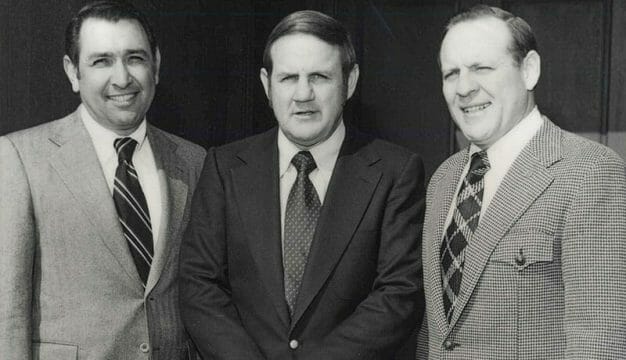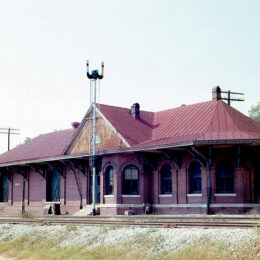Southern Preparatory Academy
Located in Camp Hill, Tallapoosa County, the Southern Preparatory Academy is a male-only military boarding school serving grades 6-12. Students come primarily from the American South, but the school has enrolled students from other areas of the United States and from other countries as well. Universalist minister Lyman Ward founded the school in 1898 as the Southern Industrial Institute and it was later named the Lyman Ward Academy. Although it has evolved since its founding, the school maintains its mission to "fit young men for the work of life."
The aftermath of the Civil War and Reconstruction exposed many people in the northern United States to the significant poverty of rural communities in the South. Numerous relief organizations and churches in the North sought to help the plight of these impoverished rural communities. The Universalist Church, in particular, was concerned about the lack of educational, theological, and economic opportunities for poor white children in these areas. In response, the Church sent ministers to assist in the theological and secular education of Universalist members and their communities. Atlanta minister Quillen Hamilton Shinn hoped to establish a school in the South similar to the ones already created by the Universalists in the North and Midwest. The school Shinn envisioned would combine theological learning with a secular education. Students at this school would then serve rural parishes throughout the South.
Shinn received approval to establish the school from the Universalist General Convention in January 1898. He initially established his school in Atlanta but quickly decided that students could best serve the rural parishes by receiving their training in a rural environment. It was around this point in time that Shinn began working with Lyman Ward.
At this time, Ward was a visiting minister for the Universalist congregation in Camp Hill. The Universalist congregation there was one of the largest in the South outside of Charleston, South Carolina. Born in New York, Ward received his theological training at St. Lawrence University and worked as a Universalist minister. While listening to a speech in New York by Booker T. Washington detailing his work with the Tuskegee Institute (present-day Tuskegee University) and providing industrial training for Black youth, Ward “felt the real call to go South.”
Shortly after marrying Mary Louis Smith in 1898, the couple moved to Camp Hill, where Ward saw firsthand the lack of educational opportunities available to poor children as many of the schools and educational programs in town and nearby were unaffordable. After visiting the Tuskegee Institute in March 1898, Ward decided to start a similar industrial school for poor white children in the South to provide them a classical education and training in industrial professions like carpentry or printing. After forming a partnership with Shinn, the two received official approval to begin their school from the Alabama Universalist State Conference. In addition to Shinn serving as president of the school and Ward as secretary, a board of trustees was created. It featured prominent Universalist and community members, including Athalia Johnson Irwin, Martin M. Teague, Robert A. Credille, A. J. Owens, Thomas Chapman, Daniel B. Clayton, H. E. Newbury, George M. Slaughter, and L. Andrews Trimble. (Notable figures George C. Wallace and Clinton Jackson Coley would serve on the board in the 1950s.)
The school opened in a three-room house in Camp Hill with a class of 23 students. Camp Hill was only supposed to be a temporary location, as Ward and Shinn had received offers from Universalist members in other towns in Georgia and Alabama to move the location of the school there, including an offer from John G. Tucker for land in Opelika. They decided to make Camp Hill the permanent location, however, because of its large Universalist congregation and the multiple donations from many local residents, including William M. Tribble, David Alexander Green Ross, William M. Conine, and the Slaughter family. The Conine and the Slaughter families both owned cotton gins and mills in Camp Hill. With the funds, Ward acquired an old plantation owned by the Brummitt family.
With classes already started and new land acquired, Ward set about constructing the Southern Industrial Institute campus, beginning with the main school building, later named Ross Hall after D. A. G. Ross. Ward and the students regularly participated in the construction of other facilities, and in short order, the campus boasted a dining hall, a barn, a carpentry factory, and a printing press. As the school grew, the administration continued to rely on donations from the Universalist community within and outside of Camp Hill. The school also received financial, material, and labor assistance from Washington and the Tuskegee Institute. During the early years of the school, Ward borrowed $800 from Washington for operational costs and also acquired bricks and manual labor donated by the institute to help construct one of the new buildings on campus.
In addition to financial difficulties, the school faced inner turmoil between Shinn and Ward. Although Shinn continued to envision the school as combining theological and secular education, Ward sought to focus more on secular education and industrial training with the belief that the focus would attract more students and expand their fundraising prospects. Eventually, the school board and Universalist Alabama State Conference decided to make the school officially independent of the church. This decision led Shinn to resign his position on the school board.
Ward would go on to lead the school for 44 years as both a principal and teacher. During his tenure, the school continued to expand, including the construction of Tallapoosa Hall, which included classrooms, a gym, and an auditorium. Ward retired in 1942 and continued to live in Camp Hill. In 1946, Ward was nominated by the Republican Party for governor of Alabama, which he ultimately lost overwhelmingly to Democrat James “Big Jim” Folsom. In 1948, Ward died and was buried on campus. He was succeeded by associate principal and alumnus Joseph Brackin Kirkland, a Mississippian who attended college in New York and would serve as principal for approximately 10 years. Kirkland was followed by two school graduates. Eli Howell was then a major in the U.S. Army who had fought in World War II in Europe. He was succeeded by Korean War veteran Wesley Smith, who served as president from 1959 to 1989.
Continuing to face financial difficulties, the school sought better financial security by attempting different means of raising funds including a capital campaign. With limited success, the school turned to requesting federal funds for a JROTC program in the 1950s. In 1955, the school added a military training program and became a military preparatory academy, and by 1962 the school was incorporated into the National Defense Cadet Corps program. This shift also brought a new name, the Lyman Ward Military Academy.
Through the 1960s and 1970s, the school continued to enroll white boys and girls. During this time, the school saw a rise in enrollment in response to the Vietnam War and the desegregation of public schools in Alabama, as enrollment in the school helped young boys avoid the draft and provided white parents with a private segregated school. The 1980s brought two significant changes in the school: it desegregated and began enrolling Black students and became male-only, leading to the graduation of the last female student in 1983.
In 2019, the school underwent another rebranding, this time changing its name to Southern Preparatory Academy. The school continues to function as an all-male military boarding school and the official military academy of the state of Alabama. Students receive a typical education based in English, math, science, and history, as well as opportunities for technical education in carpentry, criminal justice, robotics, welding, medical assistant, and the culinary arts. Students can also participate in one of their four signature programs: drone training, flight training, scuba training, and drone demonstration. While the school is no longer linked to the Universalists, the school does have a non-denominational church on campus. In addition to education, the school has an athletic program that has high school baseball, basketball, cross country, football, soccer, golf, and track and field teams.
Further Reading
- Beck, Jerri. Their Country’s Pride: The Centennial History of Lyman Ward Military Academy. Montgomery, AL: Lyman Ward Military Academy, Board of Trustees, 1997.
- Miller, Russel E. The Larger Hope: The Second Century of the Universalist Church in America, 1870-1970. Boston: Unitarian Universalist Association, 1986.








